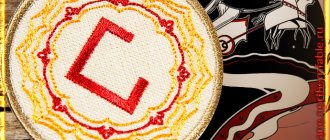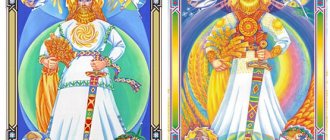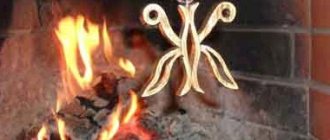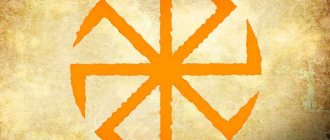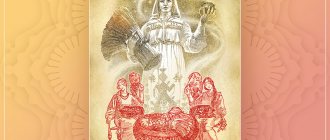Lada among the Slavs is the goddess of love, family and beauty (heavenly mother, Mother of God) patronizes love, fidelity and fertility. The personification of the feminine ideal, the keeper of the hearth. She favored families where there was harmony, and also blessed abundance.
Lada's love is pure and sincere, it honors the loyalty and respect of spouses, and can punish for treason and betrayal.
Attributes of Lada
Swans symbolize fidelity, love and strong family ties.
The main attribute of Lada is the white swan, which symbolizes purity, love and fidelity to this day.
The second important symbol of the Slavic goddess is a circle , meaning the universe with the image of an inverted (base up) triangle, symbolizing her heart.
The tree is Russian birch , endowed with magical properties and is a female tree.
The heraldic sign is a star .
Required (in other words, offering) fruits and grains from the new harvest, honey. They brought flowers to attract beauty, and coins to attract wealth.
Lelya's holiday
And if Lelya’s mother is concerned about the harvest and the preservation of love in the house, then her daughter protects new shoots and emerging sprouts. She has in her power nascent love and tender girlish dreams.
Lele was also brought gifts and lured into visiting the house. But before that, they made sure to ask her mother for permission.
Gifts for the goddess Lelya were dairy products and plant products. All this was brought to the clearing from April 22 to 23, in the young month of spring. At midnight a fire was lit, and 12 small ones were lit around it, which represented the months.
Only girls and women could come to the holiday. The men only watched from afar. All those present ate the provisions brought with prayers and songs and had fun all night.
The commandments of Lada - what are they?
The commandments of the goddess Theotokos point to the important purpose of a woman as a continuer of the family, a companion to her husband and a guardian of harmony in the family. According to the commandments of Mother Swa, the following rules for a woman’s happy life are distinguished:
- a marriage performed in the summer months will bring happiness;
- women who abandon their husbands will be deprived of happiness and joy;
- abandoning a child entails punishment: such a mother will not know peace in any of the worlds;
- everything in the house should be done with soul and pleasure, then there will be harmony in the family;
- the birth of children is the main duty of a woman-mother;
- life should be in harmony with nature, and not in opposition to it;
- a woman should honor and respect her husband, and a man should love and protect his wife;
- preserving the family is the business of each spouse; together one should go through both light and dark times, without abandoning each other;
- awakening should be with the sun, and sleep with the onset of darkness, sleep before lunch was not in honor;
- the youngest son must live with his parents and support them in old age;
- the more children, the stronger the family;
- The patron gods are the roots of the clan, they need to be respected and there will be prosperity.
Such simple canons of a happy family life where love, loyalty, care and hard work are held in high esteem were the laws of our ancestors who worshiped the Slavic gods. The relevance of these canons has not been lost in our days, only significantly fewer children are born in families, and at the same time, family ties have greatly weakened.
What does it represent in mythology, when is its day and what is the connection with other gods of the Slavs?
On May 23, the Slavs celebrated Lada Day . Other names:
- Lado.
- Ladushka.
- Woman in labor.
She is the goddess of marriage, love and beauty. The name Lada translates as “lady”.
After all, she is the foremother of numerous Slavic gods and goddesses. In marriage with the god Svarog, Lada gave birth to :
- Perun - God the Thunderer.
- Morena - Goddess of winter and death.
- Lyolya - Goddess of spring.
- I live - the Goddess of summer.
- Lelya - God of early love.
- Polel - God of mature love.
Lada and Svarog symbolize the masculine and feminine principles.
Svarog forged a ring for his beloved. Perhaps the tradition of wearing wedding rings dates back to these ancient times. It is not for nothing that in Slavic families it was customary to affectionately call a wife Lado . After all, the Goddess Lada represents the ideal wife. She must be beautiful, and smart, and affectionate, and gentle, and a good housewife - a true keeper of the hearth.
There is such historical certainty that before Christianity was adopted among the Slavs in Rus', there was a Lada temple in Kyiv. There was a sculpture depicting the Goddess. Temples dedicated to her were located throughout Rus'. In particular, on the territory of Lake Ladoga, the name of which comes from the name Lada.
The Slavs believed that the goddess Lada brings happiness to the house . It’s not for nothing that in modern Russian there are many words with the root lad:
- OK;
- foldable;
- settle;
- palm;
- pancakes.
There was a saying in Rus': “Goddess Lado, bring delight.” People believed that they could ask Lada for help in difficult moments of life , and she would definitely help. After all, Lada is friends with the Goddess of Fate Mikosh and can persuade her to change a person’s life for the better.
Mothers enjoy special protection from the Goddess. They turn to Lada if an illness or other trouble happens to a child.
After all, according to legend, Lada herself almost lost her son Perun, whom the terrible snake hid in a rock for three hundred years. Lada turned into a bird and flew around the world in search of her son. The location of Perun was suggested to Lada by the Goddess of Fate Mikosh. Perun got out of captivity and killed the snake.
Symbols and amulets for the goddess Lada
The symbols of the goddess Lada are different, where each has its own characteristics and properties, but nevertheless, they are all united by the generosity of Mother Swa aimed at those who love and honor a strong family.
The most common amulets of the Virgin Mary that have survived to this day:
- Molvinets,
- Ladinets,
- Star of Rus',
- Wedding party.
To create a talisman, the sign of the goddess is embroidered (or otherwise applied) onto clothing, jewelry or household items.
The amulet in the form of Chura to the Goddess with the Lada symbol also has power.
Magic properties of symbols
The strength of the amulet with the Star of Rus' symbol depends on its purpose. Embroidered or Painted on canvas
the star protects the home and family members. The image is placed where the family gathers together.
When used as a body amulet, it helps to achieve your goals and improve your skills.
This is interesting. The Star of Lada is very similar in appearance to the sign of the Star of Svarog, but these are completely different symbols, each having its own power.
The Ladin symbol is intended for girls, young women, and women. Represents the infinity symbol and
helps a girl grow and improve at every stage of life. Preserves beauty and health, helps to find harmony at different stages of development (daughter, girlfriend, wife, mother).
The Ladinian amulet helps to reveal femininity, which is important for creating a strong family and the ability to love.
The power of the amulet accumulates with age, the longer the talisman protects the girl. The stronger he is.
Molvinets is suitable for everyone, regardless of age, gender and profession.
The power of the protective symbol lies in protection from the evil eye, damage and other black magic created by people. It is a symbol of the family and ancestral connection of each person.
The Molvinets symbol personifies the boomerang law - every negative message directed at another will return to its creator.
The wedding dress personifies the unity of a man and a woman united by a sacred rite. It should be worn by both spouses at the same time; it is worn on the wedding day after the marriage ceremony. This symbol also means the unification of two families and helps strengthen family ties.
LiveInternetLiveInternet
Monday, May 02, 2011 14:06 + in quote book The Russians considered themselves a people professing wisdom and high cosmic love
Lada is the Slavic goddess of love and beauty. By the name of Lada, the ancient Slavs called not only the original goddess of love, but also the entire order of life - Lad, where everything should be fine, that is, good. All people should be able to get along with each other. The wife called her beloved Lado, and he called her Ladushka. “Lada,” people say when they have decided on some important matter, and in ancient times a dowry agreement was called ladnik: lady - engagement, ladylo - matchmaker, ladkanya - wedding song. And even the pancakes that were baked in the spring in honor of resurgent life are from the same root. Then they sang: Bless, mother, Oh mother, Lada, mother! Call for spring... And, of course, Mother Lyubov gave her blessing to people to call upon spring. The goddess Lada was known to many European peoples. Lithuanians and their neighbors, the Lettas, glorified Lada during the Kupala festivities. They sang: “Lada, Lada, dido musu deve!” (“Lada, Lada, our great goddess!”) - and they sacrificed a white rooster. When in the 12th century BC. e. The Dorians conquered Greece, they brought with them the cult of Lada, whose name in their language meant Lady. Since then, our Lada has firmly settled in ancient Greek mythology, she even split into two, becoming, first of all, the Titanide Leto (in Rome she was called Latona), the mother of Apollo and Artemis. It is interesting that Leto and her children assisted the Trojans (a people related to the ancestors of the Rus) against the Achaeans. Then she incarnated as Zeus’s beloved Leda, who gave birth to the Dioscuri twins. Why can we say that Leto and Leda are the Slavic Lada, what do they have in common, except for the similarity of names? Firstly, all three goddesses were associated with the cult of the white swan, the sacred animal of Lada, whose name meant, among other things, “swan”. It was for this reason that Zeus appeared to Leda in the form of a white swan. And the Lithuanians sacrificed a white rooster to Lada as a substitute for a swan (in fact, it was difficult to find swans in Lithuania in those days). Both Greek women, Leto and Leda, gave birth to divine twins, and Lada also had twins - Lel and Polel. But in the Slavic lands Lada was revered more than anywhere else. Information has been preserved that in pre-Christian times, in the lower part of Kyiv, on Podol, there was a majestic Lada temple. In the center stood a statue of a divinely beautiful woman wearing a pink wreath. Her golden hair was decorated with freshwater pearls, and her long Russian dress, tied at the waist with a golden belt, was covered with precious and complex ornamental embroidery. At the base of the statue, incense smoked and piles of flowers lay, which the attendants replaced with new bouquets every day. The temple building was traditionally built from “living” material - wood (this tradition is strictly observed, for example, in the East - in China and Japan), completely covered with silver plates. Thousands of burning candles were reflected in these silver slabs and illuminated everything around with flashes. Indeed, it was an amazing, unearthly beauty spectacle. Mythologists of the end of the 18th and first decades of the 19th century (Popov, Chulkov, Kaisarov) did not doubt its existence, accepting without verification the testimony of Innocent Gisel, who in his “Synopsis” says: “the fourth idol of Lado; Having this god of joy and all prosperity, those who are preparing for marriage offer sacrifices to him, with the help of Lad, imagining good cheer and a kind life to acquire.” Gisel drew his information about the pagan gods from the books of Polish historians Kromer and Stryjkowski. Kromer, in turn, repeated Mechovita’s speculations that Lada corresponded to the Greek Leda among the pagan Poles. In this, Mechovita disagrees with Dlugosz, who argued that among the ancient Poles Lado corresponded to the Roman Mars. At present, it can be considered proven that Dlugosz and later Polish historians derived the pagan god Lada or goddess Lada from the refrain “lado” found in folk songs. Examples of the creation of a mythical personality from an ununderstood refrain are found in mythology: for example, the Greek singer Linos owes his existence to the refrain “ai lenu” of Phoenician songs. Having inherited the goddess Lada from historians of the 16th – 18th centuries, our mythology researchers (Afanasyev and others) tried to confirm her existence among the Slavs with references to various sources, which turned out to be, according to the research of A.A. Potebnya (“Explanations of Little Russian and related folk songs”), very doubtful. The only certainty is that the refrain “lado” is found in spring, summer and wedding songs. The forms of the chorus vary: “Ay did, oh lado”, “didi-lady, di-diladushki”, “oh didi lado”, “didi ladoy”, “oh didd lado”, “lado, lado, my lado” and others. Just as in the Saratov province they say “let’s didikat”, that is, play round dance songs, from the chorus “didi”, so the Serbo-Croatian chorus “lado” gave the derived verb “ladati”, that is, to sing songs with this chorus on the eve of St. George’s Day. The word “Lada” is an old Russian one; in “The Tale of Igor’s Campaign” it occurs in 4 cases, applied to the husband; in today's Great Russian songs it is used partly in the feminine gender ("I'm looking for my sweet lada"), partly in the neuter gender ("my lado is jealous"). Lada - Female hypostasis of the Rod, Spouse of Svarog. Theotokos Lada - Mother of the gods; She is also the Woman in Labor, the “Mother of Birth”, who helps during childbirth, as well as the Goddess of abundance, ripening of the harvest and fertility. For believers - Intercessor before the gods: protects from their wrath. Later, after the baptism of Rus', She was equated with the Christian Mother of God. Lada - Goddess of marriage, abundance, harvest time. Her cult could be traced back to the 18th century; in ancient times it was common among all Slavs, as well as among the Balts. The Goddess was approached with prayers in late spring and throughout the summer. Lada was called “Mother Leleva.” Lada was associated by the Slavs with periods of summer fertility, when the harvest ripened and became heavier. There are many words and concepts associated with the name “Lada” in the Russian language, and they all have to do with establishing order: get along, get along, get along, get along, okay. Previously, the wedding agreement was called “ladins”. Lada was also considered the Mother of the twelve months into which the year is divided. Lada is the Female projection of Rod. Without this life-giving energy, Rod would never have been able to give birth to himself. And this is exactly what he does at the dawn of any young Universe he launches. Lada is the highest creative hypostasis of the Spring of the Universe; it is the powerful energy of creation. Only She is capable of blowing up the cellular structure of the Overcosmic Navi, where the volitional and mental forces of the Family that have passed through the evolutionary cycle have accumulated; not only that, but also activating the dormant information field for creative work. To give birth to itself, Rod needs the feminine creative energy of Lada. But this Power of creation and birth fills not only the Rod, It becomes the creative potential of all the highest cosmic gods of the Universe. The ancient Aryans called Her the Mother of the World, which She actually is. Her imperishable image was carved from mammoth tusks and stone by our ancestors, struggling for life in the unimaginable conditions of global cooling. It is noteworthy that they depicted not the Genus itself, but its Feminine hypostasis, which gives life to all living things. Obviously, under the conditions of the Ice Age, Lada’s vital energy was the most scarce. In order to somehow understand this high cosmic principle of creation, it is necessary to understand its name. What does this tender and touching name mean: Lada? In Russian, as always, the answer is not difficult to find. It is important to understand which word is ancient: Lada or “lad” - get along? But to do this, you need to dive into the meaning of this word. The word “lad” in Old Russian meant “agreement,” or, more precisely, “interaction.” But it is precisely the heavenly Lada that is the highest cosmic principle of interaction of all the creative forces of the Universe. Since in the Old Russian language, in sacred Sanskrit and in the Iranian languages there are no equivalent synonyms for the word “lad”, we can conclude that the name Lada is more ancient than the Russian word “lad”. This means that the psychic essence of the cosmic Goddess gave rise to the later meaning of the above words, and not vice versa. All this indicates the deep antiquity of the Female hypostasis of the Kin and Her powerful influence. The name Lada is sacred, and has not yet been fully solved. It contains the laws of the highest volitional power. In fact, it is not Rod, but Lada who rules the world; it is She who turned on the mechanism of the birth of the Universe and cleared the way for the male hypostasis of Rod. She, in her various manifestations, is the Feminine potential of all the highest cosmic gods. Lada, as befits a Great Goddess, has many forms. She also has male hypostases. For example, Lad is the god of friendship and harmony. The word “palm” comes from this word. After all, even now we extend our open palms to our friends for a handshake. It is clear that no friendship is built without the love and sympathy of a person for each other. We are talking about the soul, about the human heart, about its high feelings. The Great Lada has another famous male hypostasis. This is Lel. A small, very handsome boy is the god of bright, fiery love. Sparks fly from Lel's palms, which can ignite even the coldest heart. The ancient Greeks called Lelya Eros, and the Romans called him Cupid. Sometimes Lel turned into an attractive blond Girl - Lelya or Lyalya. The memory of Her is alive among the people to this day. But besides these two hypostases, the all-conquering Lada has another male projection. We are talking about a cheerful Delight. This is the god of joy and the rapprochement of human souls, a god who orients a person toward good, high feelings. Uslad is, as it were, the god of the emotional consequence of Lada’s energy. With all his appearance, he shows what great joy can come from love. The Indians call this god Kama. Temples of Lada stood in all ancient Russian cities without exception. They were elegant, richly decorated with beautiful wooden carvings and resembled openwork pyramids resting on carved wooden columns. In each such temple there were images of the Great Lada made by currently unknown talented Russian masters. Typically, Goddess statues were carved from wood and covered with fine gold. On the temples Her images remained wooden. Sometimes, instead of them, the sign of Lada was placed on a birch piece (birch is the tree of the Goddess) - a circle with a triangle in the middle, where the acute angle is directed downward, and the base of the triangle is directed upward. The circle here represents the universe, and the triangle is the heart of this universe. Only one statue of Lada was made of pure gold. This statue was located in the main temple of the Goddess, which once stood on the shores of Lake Ladoga. To decipher the name of the lake, it is enough to know the name Lada and the ancient Russian word meaning path - “ga”. And it turns out that Lake Ladoga simply means “the road to Lada.” And in fact, the temple of the Great Lada could only be approached from the side of the lake. From the shore, the temple complex of the Goddess was reliably covered by a huge impassable swamp, the paths through which only the wise men knew. Nowadays this swamp has almost disappeared, but in ancient times it represented a serious obstacle. The temple of the Goddess stood on the southeastern shore of the lake. And pilgrims had to sail to its pier by boat from Staraya Ladoga. The fortress of old Ladoga was a kind of key to the temple of the Goddess, the only place from where one could get to its complex. The main sanctuary of Lada consisted of several buildings, all of them were richly decorated with gilded wooden carvings, had silver-plated roofs, above which rose golden sacred symbols of the Universe, the Sun and Lada Herself, decorated with red carnelians (this stone is a symbol of the Goddess). The dome of the main temple of the Goddess of Love was, like all ancient Russian temples, an octagonal high pyramid, the top of which was crowned with a stylized gilded image of a flame - a dome. At the top of the fiery dome stood a golden double swastika adorned with precious stones, directed into the sky. The walls of the temple's interior were richly decorated with wooden, green-painted plant carvings. Green is the color of the human heart chakra, and since the heart is the receptacle of Lada energy, the ensemble of tones in the temple premises is also understandable. In addition, the temple of the Goddess of Love was richly decorated from the inside with various living plants: flowers, shrubs and even small trees. All this greenery grew in special clay pots, fragments of which are still found by people at the site of the temple burned by Christians in the mid-11th century. A naked golden image of the Great Lada stood on a stone pedestal at the altar under the dome of the temple. Little Lel sat on the bent left hand of the Goddess and smiled. The clothing of the statue of Lada consisted of three amazing wreaths: they were assembled from wildflowers skillfully made of gold, intertwined with forged silver leaves and birch earrings. One such wreath adorned the brow of the Goddess; it covered Her golden hair, styled in a high hairstyle, very similar to the decoration of the heads of Paleolithic Venuses. The second wreath hung on the shoulders of the statue, covering Her magnificent breasts, and was a kind of clothing for little Lel. The third wreath covered Her hips, and small silver bells hung from it on thin silver threads, thereby creating the appearance of a kind of skirt. Under the feet of the Goddess lay large harps - “samogudas”. According to legend, the magic harp played the hymn to the Great Lada without outside help. In other, later chronicles, it is said that these harps played with the help of the wind, which, thanks to mechanics unknown to us, was caught and vibrated not only the strings of the gusli-samoguds, but also the reeds of horns and psaltery hidden in the walls of the temple, as well as silver bells on the “skirt” of the golden statue. All these sounds merged and turned into the music of a hymn to the Heavenly Goddess. The golden statue of the Great Lada, which adorned Her main sanctuary on Ladoga, according to the Russian Vedic tradition, was made in Oriana - Hyperborea. And about forty thousand years ago it was transferred from the slowly dying Oriana to Taimyr by the first wave of settlers. The Book of Veles also speaks about the time of the exodus of the Russians (“from the great cold”) to the south. So we can consider the date of the exodus of our ancestors from their ancestral home and the time of the appearance of the Lada statue in Eurasia. For a long time, according to Vedic sources - thirty thousand years, the Taimyr Peninsula was the place from which people from Oriana-Hyperborea settled across the vast expanses of Asia and Europe. For the Hyperboreans who had lost their homeland, it appeared as a kind of second Oriana, a land that was not swallowed up by the sea and for some time was quite suitable for life. According to Herman Wirth, white people with the first blood group were evicted to the harsh Taimyr and later to the Lena River basin. These proto-Indo-Europeans, as the Russian Vedic tradition, the myths of the Avesta and the myths of the ancient Greeks tell, tried to revive the center of the fading Hyperborean civilization in North Asia. But due to deteriorating climatic conditions, this attempt failed. Another thing is important: in the south of Taimyr, in the desert cities of Putorana, in one of the grottoes for a long time there was a temple of the Family itself. And in this underground temple - a repository of Hyperborean relics, along with the statues of the main cosmic gods, there was a golden sculptural image of the Great Lada - the Female hypostasis of the Family. But not only statues of Orian gods and heroes were kept in that mountain cave temple: as a number of Vedic legends tell, deep underground in the far North the Russian people hid the Great Vesta - the writings of Svarog himself - from the eyes of the uninitiated. What kind of books these were, legends do not say. True, there are mentions in the Novgorod chronicles that in Rus' eternal books were written by “embossing” (chasing) on sheets of gold. Whether these books were golden or not is unknown. What worries us is not this, but the fact that our ancestors took two statues of gods from a hidden temple in Taimyr during the next migration to the south. One statue belonged to Veles, the other to Lada. Everything is clear here; The Russians considered themselves a people professing wisdom and high cosmic love. But it was not only the statues that the Russians took with them when they left Taimyr. Old Russian legends say that in the temples of Lada and Veles hundreds of volumes of “Vesta” were kept, allegedly copied from the heavenly Alatyr-stone itself. And if so, then the Female hypostasis of the Rod - the gentle and powerful Lada - was also the Goddess of the highest heavenly wisdom. More precisely, emotional, heartfelt wisdom, which is so clearly manifested among Russian Women. We know the path of the statue of the golden Goddess back to the hiding place of the underground temple in Taimyr. For several centuries, Her golden image was transferred by the pagan peoples of the Urals and Siberia to the east, further and further, until, finally, the Khanty guardians put it in its place in the underground Hyperborean temple. Perhaps the Great Lada “went” to the east the same way that Her golden image came from the East to the shores of Ladoga. This is also proven by the fact that after Her journey, along almost the same path, only by Russian Magi, the golden statue of Veles was transferred to the underground temple on the Putorana plateau, and in full view, under the nose of the Cossack administration. Siberian peoples knew that her husband, too, after the Golden Goddess would be hidden on Ygediayan, but this “operation” of the Volkhvami was done very cleanly, and only the Vakhov’s khanty recognized her, and even then only when the Russian guardians returned back. That is why much less is known about gold Veles than about the Golden Lada. That is why some sources, talking about the gold idol, tell about the man, while others - about the woman. As a result, information about both idols was overlapped one another and turned out to be the famous myth of the Golden Baba. “Vesta” from the Lada temple is currently stored in one of the secret caves of the Middle Urals, the book is waiting for its time. The priests knew well about the future of Russia and back in the XIV century, before transferring the goddess to the shamans of the people of Mansi, reliably hid Tom “Vesta” in a secret grotto. Well, a copy of Svarog's written from the temple of Veles is where it should be - at the feet of the mighty heavenly god of the highest cosmic wisdom. We will return to the golden Veles and talk about his wanderings in more detail. And now we will finish the narrative of Lada and its main sanctuary. As the Russian Vedic tradition tells us, the Supreme Priestesses of the main sanctuary of Lada, the Council of the Higher Magi chose even by mothers. The priests carefully tracked the most wise and beautiful women of the three classes in all the tribes of the Russian people and noted for themselves which of the women can potentially give birth to a girl that meets the requirements of the supreme priestess of the goddess of love and the consent of Lada. Typically, several dozen were gathered for such women. And among their daughters at the age of five, a special competition was arranged (several such competitions in Rus' were simultaneously held). The winner was identified at the competition and began to work with her. The Volkhvov Council chosen the chosen candidate selected special teachers, and then from ten years she was taken to study in one of the temples of Veles. After five years of training, for three years she was introduced to the supreme sanctuaries of all the highest cosmic gods, and only then she received the right to undergo dedication to the title of the Supreme Priestess of the Great Lada. This dedication was the last explosion contest, where other girls who went through the exactly the same school were initiated with her. The winner of this test and the competition became five years of the supreme priestess of Lada, and the rest of the girls made up her retinue. If the young priestess was married to the goddess before the end of her service, then a girl who took second place in the rite of initiation, etc. became in her place. The supreme priestess was the main leading in the service of Lada. She sang the anthem of the goddess on her holidays, was the first to go in round dances and games, conducted rituals of purification, initiation and sacrifice. The Great Goddess Lada as victims recognized only fresh field flowers, and cut off from the plants in such a way as not to damage it. Very often the goddess gave fresh flowers in clay pots. I must say that, without exception, all the holidays dedicated to the Higher Cosmic gods were recognized by our ancestors as the celebration of various manifestations of a single great kind. And since Lada was the female hypostasis of the builder of the universe, this, of course, was equally treated, as well as to the very clan. Therefore, all the holidays dedicated to the senior hypostases of the ancestor of the Universe-the great fiery gods-guardians-were at the same time the holidays of the genus and Lada. And vice versa, the honor of the clan and his female hypostasis automatically turned into the glorification of all, with the exception of Chernobog, the cosmic principles of the universe. Therefore, the work of the supreme priestess of the goddess of love and consent was more than enough. She especially got during the festival of Lada herself. The celebration of the goddess took place according to the old calendar on April seventeenth, according to the modern calendar - the first of May. The holiday of the Great Lada began after midnight with the dilution of six ritual lights, which were located in special places allotted for them, arranged around the Lada temple. Each fire (bonfire) was dedicated to one of the sons of the family: Svarog, Samarglu, Stribo, four -faced RA (Yarila, Kupale, Dazhbog, Hors), Veles and Perun. All these bonfires were lit by clean fire, which was divorced by friction on the altar of Lada. How this was done is well described by many researchers, so we will not dwell on this. The fire dedicated to Lada burned on the altar at the feet of her gold image. In general, the entire fiery ensemble with a temple in the center was a model of our universe, where the genus was expressed by its female hypostasis - the golden ladish, and all its energy levels - the heavenly gods - the lights of the bonfires dedicated to them, in honor of the highest cosmic principle of love and consent Dedicated to all the forces of the manifest universe, in other words, it was a holiday of the rule itself-the law that both space followed and its material and spiritual projection-man. At four in the morning, after the fire of all seven sacred lights, the singers, having built in front of the fires of the four higher heavenly gods (except Perun and Svarog), began the solemn part of the holiday with the singing of the anthem of the ancestral to the ancestral of the family, then sang the hymn of Svaroga and Perun. The genus was sang a hymn as the first indigenous principle of the universe; The Great Svarog - as its main builder, Perun - as God, completing the construction of the world. The rest of the gods sang short glory, where they were mentioned by associates, companions and guides of the will of the all -conquering fret. With the first circle of dawn, the anthem of the Zarenitsa and the powerful Yaril, following the zero, was sang, to enjoy the spectacle of the festivities of the fiery Lada and her hypostases. As soon as the first ray of Yarila in the east touched the edge of the sky, the singing of priestesses-girls and hundreds of votes of pilgrims who came to the festival of Lada to her temple, a powerful one in chorus called the goddess of love to go down from heaven to the earth of Russes. At this time, the gates of the temple opened and from them in complete protective weapons, with shields and torches in their hands instead of swords, the goddess's earthly retinue came out. And immediately, accompanying it, the anthem of the Great Heavenly Lada - the mother of all living things in the universe, the goddess of love and wisdom, the goddess of all the beautiful began to sound. This anthem began to sing the girls-ghosts of the temple, then it was picked up by all parishioners. Young quick -legged boys and girls ran to the statoes, with burning torches in their hands, soldiers, lit their torches from the sacred fire and rushed to the adjacent hills and hills, where after some time dozens of new lights dedicated to the heavenly mother of all existing . New hundreds of torches were lit from those bonfires, and the sacred fire flashed on the hills farther and farther from the temple of the goddess. Such a fiery relay race spread over huge spaces in a few hours, where every hill with a bonfire at its top became a sacred place, where, according to our ancestors, the high grace of Lada would certainly go down from heaven. At the tops of the hills and hills at the sacred fire of the goddess, people gathered, sang hymns, arranged in honor of Lada common meals, on which freshly baked sour cream pancakes were an obligatory dish. It was believed that the pancakes eaten at the pure fire during this holiday are able to give rise to a feeling of love for all living things in the soul of the most proud person, without which human life loses all meaning. But back to the temple. During the sound of the anthem, the goddess, after the fourteen torchs in the armor, appeared fourteen warriors with shields in their hands and gold falcons (rushes) on helmets. These warriors carried on their free shoulders a round, decorated around the perimeter with yellow knitted brushes, a wooden platform, which is a stylized image of a double swastika. In the center of this swastika, on a round layer of greening Trin, which was supposed to personify the “mother of the Earth cheese”, stood naked, in the garlands of the first wildflowers, the supreme priestess of the Great Goddess. The procession of the Gritsa girl closed, each of which on a special tray in the form of a double swastika carried several dozens of wreaths of wreaths consecrated by the altar of wildflowers. At the sight of a living fret in the image of the supreme priestess, the anthem of the glorification of the goddess intensified and reached his climax. At this moment, it seemed that all nature - forests, rivers, lakes and the sky itself - sings the glory to the universal principle of high love and wisdom. On raising the hand of the goddess, the anthem subsided, silence came, and only her voice was heard. The Goddess Lada in the image of the High Priestess (and our ancestors believed that on her holiday the great goddess enters the girl’s body) talked with the people. She said that she was worried, and what needs to be done in order to resist the movement of evil in human souls. The goddess in the image of priestess freely called the people the names of the greedy and evil princes, the presumptuous boyars and elders, people who ceased to serve the Russian land and its people. The goddess’s speech at his festival sounded expedient as a sentence, and who came to the holiday as a guide to action. People who were popularly abandoned Lada, it doesn’t matter whether they or even princes, in ancient Russian society, automatically lost their support for the masses and became outcasts. But the Great Lada, through her supreme priestess, called the names and heroes, people who are, on whom the well-being and wealth of Russian land rests. These people became Lada favorites, the goddess's speech revealed to them the way to the levers of power and universal fame. The main criterion of the goddess was virtue. Therefore, in Rus' they sometimes called Lada and the goddess of virtue. This is understandable, virtue does not happen without a feeling of love and justice. After her appeal to the people, the Great Goddess left the body of her supreme priestess. At the same time, the recent proud and majestic naked Lada suddenly knelt down and covered her face with her palms. At the same time, warriors lowered the platform with the supreme priestess to the ground, and the girls - the younger priestesses, put it on the lush festive white clothes. And when the warriors raised the platform again, it was already an earthly, very beautiful girl who, raising her hands to the sun, began to sing the anthem Lada fair to the sun, in a high and strong voice. At the same time, the choir of voices echoed her. After the anthem Lada fairly, the supreme priestess of the goddess approached the fire (fire) dedicated to Svaroga, climbed a small ritual mound-hork and proceeded to the distribution of wreaths consecrated in the temple. Each wreath of the supreme priestess put on the head of a approaching person with his own hands. Only such a wreath was considered full -fledged in the energy aspect. Usually he was stored for a year before the next holiday of Lada and believed that he would bring happiness in love and good health. After the distribution of centuries, the largest bonfire was lit in the central square near the temple, now the Lada of Heaven, who came; Moreover, the fire for its breeding took from the coals of all six external bonfires, which by this time had already burned out. This ritual once again showed that the energy of Lada consists of the energies of the entire space. In other words, love is Lada, and Lada is space. And not hatred rules the world, but a high all -conquering love. Around the central fire, ritual festive round dances began, which were organized by priestesses. Rounders in honor of the heavenly gods were accompanied by the music of hymns, choral singing and recitatives. After round dance and hymns, the gods and heroes arranged a sacrifice to Lada. Everyone, both men, and women, and old people, and children lined up in one giant round dance, took hands and went to the temple to the golden statue of the goddess, at the feet of whose bouquets of wildflowers were laid. It was the most crucial moment for the magic group of the temple, because the hearts of people merged on the image of Lada, a very strong energy unity arose, and it had to be directed for the benefit of the Russian land and the entire Russian people. Typically, the magical group of the temple of the goddess of love consisted of experienced leading no younger than thirty -three years. These women, once being chosen in a group of young priestesses, never left the walls of the temple. Often among them there were also former supreme priestesses of Lada. Women-Vedeniy were the main keepers of esoteric knowledge. They freely read any ancient texts, knew the key to the decoding of “Vesta”, engaged in the education of young priestesses and taught the supreme priestess, but their main concern was magical practices and the organization of the correct sex education of Russian youth. These beautiful and experienced women, who had a lot of male worshipers throughout the Russian land, who knew the psychology of man perfectly, were invaluable consultants on the issue of sexual education and the proximity between a man and a woman. After the sacrifice of Lada, which was the peak of magical practice, the parishioners installed tables and benches in the square in front of the temple, decorated with flowers a common meal - a feast in honor of the high goddess. They cooked on a festive table as a symbol of heavenly Navi, fish dishes, drank mainly Surah and Beznitny, sometimes they consumed poultry meat, mainly waterfowl, and certainly ate various buns in the form of pigeons (pigeon - a sacred Lada bird), and with a honey infusion herbs - pancakes. After a common meal, it was possible to once again sacrifice the goddess, but only by pancakes. They were usually put into the fire of a fire, which burned in the square near the temple. As a rule, the pancakes brought the goddess of love young people, asking her happiness when choosing a satellite or companion of life. The feast has not yet ended, and already in the square around the temple the fun began. This time, people danced, played pantomims, listened to the performances of buffoons and traditions of the storytellers of epics, arranged funny fights with straw bags, beaten and threw lakes or rivers of Chernoboga into the water. After dancing, songs and reckless fun, the time of various games came. The main game for the festival of Lada was considered burners. Russian people represented love with hot, hot. As a rule, young unmarried guys and girls played the burners. And adults and old people (we did not make a reservation, in Rus' we were happy to take part in games and old people) preferred other games, where the ingenuity, dexterity, and strength were needed. Without exception, all the game, not only at the festival, but also on other holidays of the Hypostases of the clan, carried a deep esoteric meaning. But this is a separate topic. . And in conclusion about the cult of heavenly Lada, I would like to add that during the Great Patriotic War, the German divisions were stopped by units of the Red Army on the southern coast of Lake Ladoga in the place where the main sanctuary of the female hypostasis of the clan-the great and wise fret once rose. Perhaps the energy of the goddess also intervened in the affairs of the war, because how much the Germans did not try to completely surround the Lake Ladoga, they could not do this. The conqueror never stepped on the sacred land of the ancient temple of a high goddess
| Categories: | Vedic Rus' |
Cited 5 times Liked by: 3 users
Like share
0
Like
- 3
I liked the post - Quoted
- 0
Saved
- Add to quote book
- 0
Save to links
Liked3
0
Amulet doll Lada
The Lada doll harmonizes the energy of the house, fills the home with feminine warmth and love. The protective doll protects all family members. It should be made from linen fabrics or cotton; flax and straw are also suitable.
The doll is made using folk art techniques without using a needle. After making the Lada, be sure to decorate it with various beads and ribbons. Embroidery of one of the signs of the goddess on the apron will fit well; flowers, white birds and other attributes of love can be used in decoration.
To decorate the protective doll of the goddess Lada, white birds, flowers, natural stones, beads, and embroidery are suitable.
The doll is placed in a prominent place in the room where the whole family gathers together. Abundant decoration with ribbons, beads, and flowers is encouraged.
Star tattoo
A tattoo depicting the Lada star has magical properties and has a serious impact on a person’s destiny. A person wearing an image on his body is under the protection of the goddess.
When tattooing any Slavic symbol on the body, do not change the outline of the main image. Any changes are reflected in the influence of the sign.
Another important point is a conscious approach to choosing the sign of Rus'. In the absence of faith in a given culture and a life that contradicts the canons of the Slavic gods, it is better to choose other images that do not carry sacred meaning.
